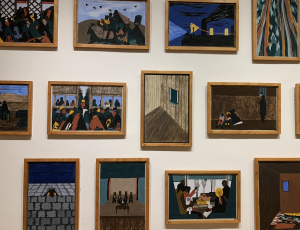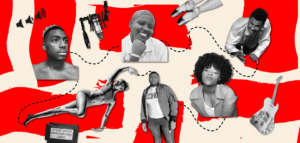The Holocaust Museum
Address: 100 Raoul Wallenberg Pl. SW
How to get there: Take the 33 bus south to Federal Triangle and get off at Pennsylvania & 14th. Walk down 14th until you reach the museum.
Admission: Free! (Timed entry passes required)
Content warnings: antisemitism, discrimination, graphic depictions of violence, and sexual violence
The United States Holocaust Memorial Museum is a somber and industrial home of living memory, chronicling the rise of antisemitism and the Nazi Party in Germany and the sickening atrocities committed as a result. It cannot be overstated that this memorial is deeply upsetting and can be highly triggering in its portrayal of the physical and ideological evils perpetrated during the Holocaust, particularly for those with connections to the targeted populations. For those who do go, the museum offers incredibly powerful documentation of the events that culminated in such a swift and horrific genocide—from detailing how indoctrination occurs to stories of resistance—and serves as a hallowed memorial to the lives lost and the populations decimated. In a world in which many understate the impact of the Holocaust, and some even deny it, the Holocaust Museum provides a constant reminder and vital source of primary information. Everyone should visit the Holocaust Museum at some point to truly witness and digest the monstrous acts that human beings can commit against one another, and join the museum’s vow that it shall never happen again.
— Lucy Cook
Anacostia Community Museum
Address: 1901 Fort Pl. SE
How to get there: Take the GUTS bus to Rosslyn, the Blue line to L’Enfant Plaza, then transfer to the Green line and take that to Anacostia. Once off the Metro, take the W2 bus east towards United Medical Center and get off at Fort Pl. SE & #1901.
Admission: Free!
While certainly a hike from Georgetown, the Anacostia Community Museum (ACM) is the only Smithsonian that truly serves as a memorial and monument to this city. In particular, the ACM focuses on recognizing the legacy and collective power of the Anacostia community, one of D.C.’s historic and contemporary Black neighborhoods. The current exhibit, “Food for the People: Eating and Activism in Greater Washington,” focuses on civic engagement in urban areas, specifically the unequal distribution of food resources in and around the District. The exhibit mixes art installations, videos, and hands-on activities. Beyond art, the museum hosts many speakers—often community members who educate through their stories. The ACM is an excellent place for any resident, new or D.C.-born, to learn more about their neighboring communities and the city they have stepped into.
— Lucy Cook
The Phillips Collection
Address: 1600 21st St. NW
How to get there: Take the GUTS bus to Dupont, then walk up Massachusetts Avenue until you reach 21st Street, where you will take a right.
Admission: $10 if you show a student ID, or if you’re still 18 or under you get in free
At first glance, The Phillips Collection looks like just another mansion on Embassy Row. But if you take a closer look, you’ll soon realize that not only is it a massive house, it holds a massive (6,000 strong!) collection of works by renowned artists like Georgia O’Keeffe and Pablo Picasso. The museum’s interior mostly resembles a traditional gallery, with glittering white walls and a large central staircase, but visitors can also enter Duncan and Marjorie Phillips’s original home. In here, paintings flank fireplaces and wooden floors creak. Just don’t accidentally go down the wrong staircase (as my friend and I once did), because you will be stuck in the catacombs of basement offices (it took us about 15 minutes of seemingly endless searching to find our way up). And once you finally emerge upstairs, be sure you don’t miss the Rothko room, a space that showcases the work of Mark Rothko. The capacity limit due to COVID-19 restrictions means it will just be you and the art.
— Olivia Martin
Hillwood Estate, Museum & Gardens
Address: 4155 Linnean Ave NW
How to get there: Take the 38B to 17th & I, then transfer to the L2. Get off at Connecticut & Tilden.
Admission: College students are $10, and adults are $15
Hillwood is a mansion museum near northern Rock Creek Park, showcasing the home of 20th century cereal-heiress Marjorie Post, who amassed a large personal collection of Russian imperial and 18th century French art. Post’s home is a mismatch of ideas: Fabergé eggs and portraits of European nobility reside within a 1950s house built to look like a Georgian mansion. Although Post cycled through several husbands, Hillwood retains few of their marks. This is undoubtedly Post’s personal estate. Her bedroom is a space full of comfort, all blue frills and a large vanity, and her bathroom is filled with pink tiles and pictures of her daughters and pets. She has her own hairdressing salon and several walk-in closets. Little silver boxes on the doors to bedrooms let the maids know whether the residents can be disturbed or not. Post hosted large gatherings in this home, and the size of the dining room and kitchens attest to their grandiosity. The estate also encompasses a large outdoor garden divided into several segments such as the French garden, Japanese garden, rose garden, orchid greenhouse, Russian dacha, Adirondack wood cabin, and her beloved pets’ resting place, the dog cemetery.
— Panna Gattyan
The Postal Museum
Address: 2 Massachusetts Ave. NE
How to get there: Take the GUTS bus to Dupont, then take the Red line to Union Station and cross the street. Alternatively, take the GUTS bus to the Law Center and walk three blocks to Mass Ave.
Admission: Free!
A museum dedicated to mail may sound about as interesting as a finance major’s summer plans (sorry), but trust me, the Postal Museum will make you look at mail in a whole new light. Located in the beautiful and historic City Post Office Building, exhibits take you on a journey along a Colonial post road, on the Pony Express, into a 19th century stagecoach, and through a small town 1920s post office, exhibiting the way mail acts as a vessel of shared information and culture. Perhaps this is a museum that would quite literally only be fascinating to fellow American Studies majors, but maybe you’re also a massive dweeb who thinks that hyper-specific museums are kind of neat. Either way, the Postal Museum is the perfect fit for you.
— Lucy Cook
Hirshhorn Gallery
Address: Independence Ave. SW &, 7th St. SW
How to get there: Take the GUTS bus to Rosslyn; take the Blue line towards Largo Town Center and get off at L’Enfant Plaza. The Hirshhorn Gallery is located two blocks away on the National Mall.
Admission: Free!
Of the numerous art galleries littered throughout D.C., the Hirshhorn Gallery offers one of the most immersive and thought-provoking experiences. Featuring contemporary art that mixes media, often with a digital twist, the Hirshhorn Gallery seeks to place its visitors within the art itself. One massive hit exhibit was Yayoi Kusama’s famous Infinity Mirrors in 2017, in which patrons amble amongst glowing lights reflected thousands of times. This magical exhibit resembled a trip to another world or an escape to the stratosphere. Exhibits like Barabara Kruger’s “Belief+Doubt” that wraps the entire space—ceilings, floors and walls—in bright and demanding vinyl, frequent the Hirshhorn. To many art lovers the Hirshhorn is far too well-known and highly regarded to be placed on a lesser known museums list. But for the casual museum-hopper this gallery might provide a fresh new take on how one can experience art.
— Lucy Cook
Kreeger Museum
Address: 2401 Foxhall Road, NW
How to get there: It’s 40 minutes on foot from campus, or a 25 minute walk if you take the Wisconsin GUTS bus up to Calvert & Wisconsin first. Free parking onsite.
Admission: Free! (Timed entry passes required)
Kreeger is a small museum focusing on modern and postmodern art. When I first came here I thought the building was cold and unattractive from the outside, all grayish white and sharp black lines, like seeing Lauinger Library’s little cousin. Yet once I stepped inside, the space was transformed. It was filled with warm wood, tall ceilings, and beautiful wide windows. It was somewhere I would love to call my home. The museum includes works of 20th century America, European impressionism, exhibits of African and Asian artists, Washingtonian-focused pieces, rotating exhibitions, and both old and contemporary outdoor sculpture gardens. All the rooms on the ground floor are open and inviting, mostly filled with paintings. Smaller rooms in the basement or in the side offices regularly showcase temporary exhibitions. There’s an inner courtyard that the building encircles, with tall windows through which you can see lush, wide greenery and sleek, curved sculptures. You first enter the garden through the back terrace, filled with dark stone life-sized sculptures. The staircase leads down to tall, white structures standing like sentinels around a fountain pool. When you continue through the garden, you’ll encounter more contemporary three-dimensional works that challenge form, material, and perspective. One work consists of long orange strands intertwining against a real tree in the garden, like a giant caterpillar or woven ladder. A little further away, an odd machine moves subtly through unnerving motions, such as a hand creeping back and forth with a pointed finger.
— Panna Gattyan





